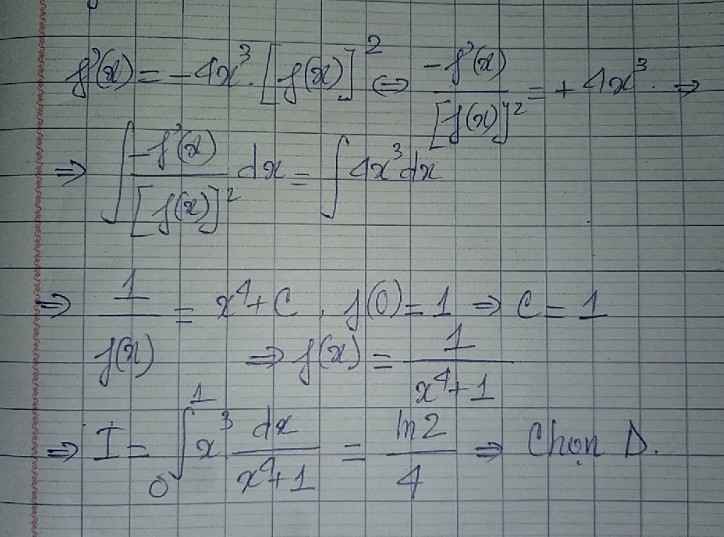Hãy nhập câu hỏi của bạn vào đây, nếu là tài khoản VIP, bạn sẽ được ưu tiên trả lời.

\(f'\left(x\right)=-e^x.f^2\left(x\right)\Leftrightarrow\frac{f'\left(x\right)}{f^2\left(x\right)}=-e^x\)
Lấy nguyên hàm 2 vế:
\(\int\frac{f'\left(x\right)}{f^2\left(x\right)}dx=-\int e^xdx\)
\(\Rightarrow-\frac{1}{f\left(x\right)}=-e^x-C\)
\(\Rightarrow f\left(x\right)=\frac{1}{e^x+C}\)
\(f\left(0\right)=\frac{1}{2}\Rightarrow\frac{1}{1+C}=\frac{1}{2}\Rightarrow C=1\)
\(\Rightarrow f\left(x\right)=\frac{1}{e^x+1}\Rightarrow f\left(ln2\right)=\frac{1}{e^{ln2}+1}=\frac{1}{3}\)

Câu 1:
\(2f\left(x\right)+3f\left(\frac{2}{3x}\right)=5x\) (1)
Đặt \(t=\frac{2}{3x}\Rightarrow x=\frac{2}{3t}\)
\(\Rightarrow2f\left(\frac{2}{3t}\right)+3f\left(t\right)=5.\frac{2}{3t}\Leftrightarrow2f\left(\frac{2}{3t}\right)+3f\left(t\right)=\frac{10}{3t}\)
\(\Rightarrow2f\left(\frac{2}{3x}\right)+3f\left(x\right)=\frac{10}{3x}\Leftrightarrow3f\left(\frac{2}{3x}\right)+\frac{9}{2}f\left(x\right)=\frac{5}{x}\) (2)
Trừ vế cho vế của (2) cho (1):
\(\frac{5}{2}f\left(x\right)=\frac{5}{x}-5x\Rightarrow f\left(x\right)=\frac{2}{x}-2x\)
\(\Rightarrow\int\limits^1_{\frac{2}{3}}\frac{f\left(x\right)}{x}dx=\int\limits^1_{\frac{2}{3}}\left(\frac{2}{x^2}-2\right)dx=\left(-\frac{2}{x}-2x\right)|^1_{\frac{2}{3}}=\frac{1}{3}\)
Câu 2:
\(3f\left(x\right)-4f\left(2-x\right)=-x^2-12x+16\) (1)
Đặt \(2-x=t\Rightarrow x=2-t\)
\(\Rightarrow3f\left(2-t\right)-4f\left(t\right)=-\left(2-t\right)^2-12\left(2-t\right)+16\)
\(\Rightarrow3f\left(2-t\right)-4f\left(t\right)=-t^2+16t-12\)
\(\Rightarrow3f\left(2-x\right)-4f\left(x\right)=-x^2+16x-12\)
\(\Rightarrow4f\left(2-x\right)-\frac{16}{3}f\left(x\right)=-\frac{4}{3}x^2+\frac{64}{3}x-16\) (2)
Cộng (1) và (2):
\(-\frac{7}{3}f\left(x\right)=-\frac{14}{3}x^2+\frac{28}{3}x\)
\(\Rightarrow f\left(x\right)=2x^2-4x\)
\(\Rightarrow\int\limits^2_0f\left(x\right)dx=\int\limits^2_0\left(2x^2-4x\right)dx=-\frac{8}{3}\)

\(h\left(x\right)=f\left(x^2+1\right)-m\Rightarrow h'\left(x\right)=2x.f'\left(x^2+1\right)\)
\(h'\left(x\right)=0\Rightarrow\left[{}\begin{matrix}x=0\\f'\left(x^2+1\right)=0\end{matrix}\right.\) \(\Rightarrow\left[{}\begin{matrix}x=0\\x^2+1=2\\x^2+1=5\end{matrix}\right.\) \(\Rightarrow x=\left\{-2;-1;0;1;2\right\}\)
Hàm có nhiều cực trị nhất khi \(h\left(x\right)=m\) có nhiều nghiệm nhất
\(f\left(x\right)=\int f\left(x\right)dx=\dfrac{1}{4}x^4-\dfrac{5}{3}x^3-2x^2+20x+C\)
\(f\left(1\right)=0\Rightarrow C=-\dfrac{199}{12}\Rightarrow f\left(x\right)=-\dfrac{1}{4}x^4-\dfrac{5}{3}x^3-2x^2+20x-\dfrac{199}{12}\)
\(x=\pm2\Rightarrow x^2+1=5\Rightarrow f\left(5\right)\approx-18,6\)
\(x=\pm1\Rightarrow x^2+1=2\Rightarrow f\left(2\right)\approx6,1\)
\(x=0\Rightarrow x^2+1=1\Rightarrow f\left(1\right)=0\)
Từ đó ta phác thảo BBT của \(f\left(x^2+1\right)\) có dạng:

Từ đó ta dễ dàng thấy được pt \(f\left(x^2+1\right)=m\) có nhiều nghiệm nhất khi \(0< m< 6,1\)
\(\Rightarrow\) Có 6 giá trị nguyên của m



